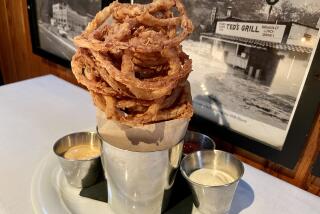Homegrown Onions Can Develop Enduring Appeal
- Share via
Onion leaves flopping over, wilting, and turning yellow show that the bulbs beneath are ripening. If you allow these bulbs to gradually dry off and cool down, you could still be using them fresh next March, or later.
The ripe onion is a storage bulb, much like a tulip, designed to let the plant “sleep” out adverse conditions, such as heat or cold. Young onion plants grow only leaves. But when daylight reached a certain critical number of hours, specific to each variety, something inside the plants says: “Stop making leaves; start storing food.”
As leaves on each variety cease growth, energy is pumped into the base of the plant, which swells up into a bulb. It is that stored energy--sugars--that makes onions taste good.
Once the bulbs have stored enough energy, the leaves wilt for they are no longer needed. These ripening bulbs sit almost on top of the ground, their shoulders happily exposed to the warm sun.
Even for a single variety, you will not find all the onion tops flopping down at the same time, so it helps to coax along “hesitant” ones by knocking over their green tops. If you wait too long for all your onions to ripen by themselves, rainy weather might wake up those that have already begun to sleep.
As ripening continues, root growth stops and bulbs practically lift themselves up and roll out of the soil. At this stage, harvest any onions still nestled in the soil, then spread all of them in a single layer on top of the ground.
After a week of basking in the hot, dry sun, the onions, their tops shriveled and necks thin, are ready for storage. Pack bulbs into mesh bags or--for something both decorative and practical--braid them into ropes. Put aside any onions with thick necks, for these will not keep and should be refrigerated for quick use.
For long-term storage, onions need to be kept dry and gradually cooled to temperatures just above freezing. You might leave the bags or braids hanging in your garage into the fall, then move them to a cool basement or attic just before the weather turns frigid.
Even under the best storage conditions, onions eventually sprout as stored food is mobilized and the onions start to grow again, this time making just a few leaves, then flowers and seeds.
American-type onions, such as Ebenezer, Danvers, and Globe, are typically firm and pungent, and they are the kinds that keep best. European-type onions such as Sweet Spanish and Walla Walla, are softer and sweeter. They are only supposed to keep a couple of months, but harvest and cure them carefully. Then keep them cool and dry, and you might still be putting fresh slices into salads and sandwiches well into winter.
More to Read
Eat your way across L.A.
Get our weekly Tasting Notes newsletter for reviews, news and more.
You may occasionally receive promotional content from the Los Angeles Times.








